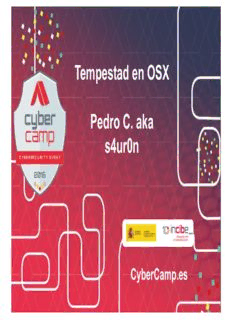
Tempestad en OSX Pedro C. aka s4ur0n PDF
Preview Tempestad en OSX Pedro C. aka s4ur0n
Tempestad en OSX Pedro C. aka s4ur0n cccccccccccccccccc CyberCamp.es Whoami class PedroC: def __init__(self): self.name = ‘Pedro Candel’ self.email1 = ‘[email protected]’ self.email2 = ‘[email protected]’ self.website = ‘https://www.s4ur0n.com’ self.nickname = ‘@NN2ed_s4ur0n’ self.role = ‘Security Researcher’ self.interest = [ ‘Reversing’, ‘Malware’, ‘Offensive Security’, ‘…’ ] self.member_of = [ ‘mlw.re’, ‘OWASP’, ’NetXploit’, ‘…’ ] 2 Concepts Introduction Covert Channel A covert channel is a type of computer security attack that creates a capability to transfer information objects between processes that are not supposed to be allowed to communicate by the computer security policy. The term, originated in 1973 by Lampson, is defined as "(channels) not intended for information transfer at all, such as the service program's effect on system load" to distinguish it from legitimate channels that are subjected to access controls. Source: https://en.wikipedia.org/wiki/Covert_channel Tempest TEMPEST is a National Security Agency specification and NATO certification referring to spying on information systems through leaking emanations, including unintentional radio or electrical signals, sounds, and vibrations. TEMPEST covers both methods to spy upon others and also how to shield equipment against such spying. The protection efforts are also known as emission security (EMSEC), which is a subset of communications security (COMSEC). Tempest The NSA methods for spying upon computer emissions are classified, but some of the protection standards have been released by either the NSA or the Department of Defense. Protecting equipment from spying is done applying distance, shielding, filtering and masking. The TEMPEST standards mandate elements such as equipment distance from walls, amount of shielding in buildings and equipment, and distance separating wires carrying classified vs. unclassified materials, filters on cables, and even distance and shielding between wires/equipment and building pipes. Noise can also protect information by masking the actual data. Tempest While much of TEMPEST is about leaking electromagnetic emanations, it also encompasses sounds or mechanical vibrations. For example, it is possible to log a user's keystrokes using the motion sensor inside smartphones. Compromising emissions are defined as unintentional intelligence-bearing signals which, if intercepted and analyzed, may disclose the information transmitted, received, handled, or otherwise processed by any information-processing equipment. Source: https://en.wikipedia.org/wiki/Tempest_(codename) Tempest Attacks Data from electromagnetic waves Tempest Attacks TEMPEST Attacks work on the principle that electronic devices such as monitors and fax machines emit electromagnetic radiation during normal use. With correct equipment such as antennas, receivers and display units an attacker could in theory intercept those emissions from a remote location (from across the street perhaps) and then replay the information that was captured. Tempest Attacks Imagine if this were possible how it could be misused to violate your privacy… Closing doors and blinds wouldn't do anything to stop a TEMPEST attack. If your monitor was displaying sensitive material then it would be exposed. However don't become paranoid for it's extremely difficult to execute an attack to "capture" what's being displayed, but in theory it's certainly possible.
Description: